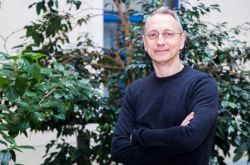Why did you choose to go to the States on a Fulbright program?
An acquaintance of mine, researcher Georgiy Bobashev with whom we long wanted to do a joint project, works in the USA. As I browsed through the different opportunities that would’ve made a joint project possible, I remembered about the Fulbright program.
Tell us more about your research.
I work with influenza propagation models. Georgiy Bobashev also collaborated with the St. Petersburg Research Institute of Influenza on this topic some ten years ago, but it was brought to a halt. We decided that ITMO University can become an important link between the Research Institute of Influenza and RTI International, where Georgiy works, and provide for the continuation of the project.
RTI International is a major research organization in the USA. Among its products are the so-called synthetic populations. To put it crudely, those are artificially generated population censuses that have no connection to real people. The use of real censuses contradicts personal data protection laws, which is why their synthetic counterparts are being used. Synthetic populations are similar to real ones but don't contain private data.

Our idea was to adopt RTI International’s technology of generating synthetic populations (they already have quite a collection of such populations for different regions of the USA and other countries) and create such a population for St. Petersburg. We wanted to use it as a basis for a detailed influenza propagation model in St. Petersburg. The results were to be compared with the ones we got from using simpler models.
We wanted to show that using more detailed models has a better effect. When representing the population in a more simplified manner (for instance, as several age groups) we lose lots of important information that affects influenza dynamics. For instance, we can’t understand where each individual spends their days, hence who exactly they can infect. Detailed models allow us to depict the spread of infection in a more realistic manner and see who, where and why gets ill.
You spent over half a year in the States and visited several cities. What was your working process like?
According to the rules for Fulbright Visiting Scholars, a participant can come to the USA for a term of three to six months. It is up to them to decide how much time they need to complete their project. In my case, it was six months. What is more, the J-1 visa that you get allows you to arrive a month before the project starts and leave within a month after it ends. This additional time is not covered by the program’s funding. One can use it to settle at the new place or to travel across the country.
My friends who followed my updates on social media got the impression that I traveled a lot. To say the truth, I indeed got to travel some; on weekends and holidays, that is. I spent the rest of my time in North Carolina, working on the project. Most of it was spent with Georgiy Bobashev, but I also communicated with other specialists from the Center for Data Science, a department of RTI International. I also helped Georgiy’s PhD student from NC State University with another project on synthetic populations.

What results have you achieved?
We already sent one article to a journal with quite a high impact factor, which is currently being reviewed. We also prepared proceedings based on the project that Georgiy’s PhD student did for the SBP-BRiMS 2018 conference, which I co-authored. We got the first place in the report contest in our category, and are currently working on another article. What is more, we have materials for two more articles that we hope to send to journals by the end of the year.
And what are the possible practical applications of your results?
Modeling relies on data. Detailed models need detailed data. In case of modeling the situation in St. Petersburg, the initial pools of data that we have now are often disorganized and inconsistent. Therefore, in order to create a detailed model for any process related to movement and interactions of people in the city, be it influenza dynamics, distribution of information, of transport mobility, you first have to organize separate pools of data in order to describe the population. Each research team has to do that independently from others and start from scratch, which means additional work. But if we were to have a ready synthetic population with a good description and statistical justification of its correspondence to St. Petersburg’s real population, and references to initial data sources, any researcher would be able to make use of it for their projects.

This is the approach used by RTI International. Their specialists create synthetic populations, make them available to the public, and let scientists use them for their models. I have a draft of such a population for St. Petersburg, and I continue working on it. In the near future, my colleagues from the Institute of Design & Urban Studies and I are going to discuss its application in solving the tasks of urban planning.
What are the differences in the working process here and in the USA?
The first thing that stands out is the schedule. At RTI International, people start working early in the morning, but leave early, as well. By about 5 pm, there are almost no people in the building except for maybe janitors. Still, by 7 am the place is already humming with activity, the canteen is open, and employees have their breakfasts while already working on their laptops.
Was it hard to adjust?
In fact, I always wanted to learn to get up early. My research advisor here gets up at 5:45 in the morning. In the US, I got the chance to try this myself.
As for the work itself, in the US building a career is the most important thing in life, especially if we’re talking about the older generations. If someone signs an employment contract, they do their best to effectively perform their responsibilities. Research organizations like RTI International are more informal than commercial institutions, but the monitoring of work processes is still organized in quite a strict manner.

For instance, every employee works on several projects, and they are paid for a particular amount of hours. The researchers have to fill in forms in a dedicated electronic system to state how many hours they’ve worked on particular projects on a particular day. The total amount of hours has to correspond to the time they have been given for a particular project.
They also use an original system to encourage departments to hire efficient employees: when any department hires a new employee, they pay the main office a fee for their workplace. Finally, among the KPIs of an employee is how many projects they complete and how much money they bring to the company as result.
Do you plan to return to the USA to continue working on this research, or start some new project?
One of the ideas that me and Georgiy Bobashev came up with is to try and establish cooperation between ITMO and RTI International. The American side has many competencies that can be of use to us, especially everything that has to do with processing poll data. On the other hand, we have competencies, tasks and projects that their specialists would’ve liked to participate in. For now, we are working out different options for how such relationships can be fashioned. And I believe that this initiative has a bright future.





